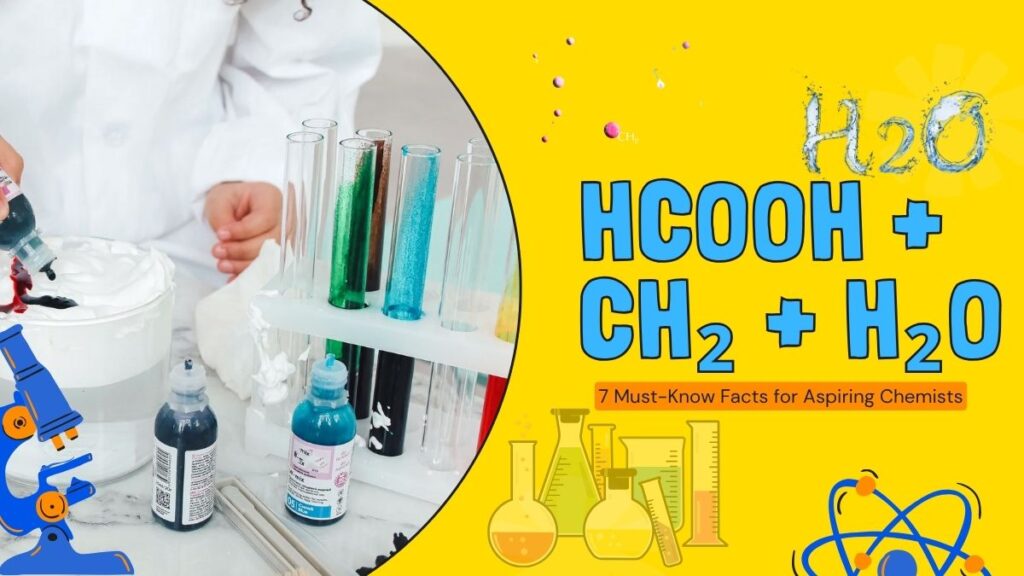Introduction
- Introduction
- 1. 🧪 What Are HCOOH, CH₂, and H₂O?
- 2. ⚗️ Formic Acid (HCOOH): Dual Functionality
- 3. ⚛️ CH₂: The Power of the Methylene Group
- 4. 💧 Water (H₂O): The Universal Facilitator
- 5. 🔁 Combined Chemistry: HCOOH + CH₂ + H₂O
- 6. 🌍 Practical Applications
- 7. 🎓 Key Takeaways for Students and Professionals
- 📈 Expert Tips to Master These Concepts
HCOOH + CH₂ + H₂O If you learn organic chemistry, you will often see molecules such as formic acid (HCOOH), methylene (CH₂) and water. These small but powerful molecules appear in many reaction mechanisms, from simple laboratory experiments to complex industrial processes.
In this article, we’ll explore their chemical properties, reactions and most importantly how they work together. You’ll also get step-by-step guides to understanding their behavior in reactions, making this a perfect learning resource for students and aspiring chemists.
1. 🧪 What Are HCOOH, CH₂, and H₂O?
Before you can understand how these compounds work together and you need to know what they are:
| Molecule | Name | Role in Chemistry |
| HCOOH | Formic Acid | Weak acid, reducing agent |
| CH₂ | Methylene | Carbene intermediate, highly reactive |
| H₂O | Water | Solvent, reactant, stabilizer |
These small molecules form the backbone of many organic synthesis and reaction mechanisms.
2. ⚗️ Formic Acid (HCOOH): Dual Functionality
Formic acid is not just a simple acid—it’s reactive and resourceful.
🔬 Key Functions:
- Acid Behavior: Donates protons (H⁺) in acid-base reactions.
- Reducing Agent: Can break down into H₂ and CO under heat or with a catalyst.
- Green Chemistry Tool: Used as a sustainable source of hydrogen.
🔄 Step-by-Step: Formic Acid Decomposition
- Heat HCOOH or add a catalyst.
- It decomposes into CO + H₂.
- Hydrogen gas can reduce double bonds or other molecules.
This makes formic acid a clean, controllable energy source in many lab settings.
3. ⚛️ CH₂: The Power of the Methylene Group
CH₂, particularly as a carbene (:CH₂), is one of the most reactive intermediates in organic chemistry.
🔬 How CH₂ Works:
- Forms Bonds: Adds to C=C double bonds (e.g., cyclopropanation).
- Inserts into Chains: Creates new carbon-carbon connections.
- Appears in Polymers: Backbone unit in plastics like polyethylene.
🔄 Step-by-Step: CH₂ in a Reaction
- Generate CH₂ carbene using diazomethane or similar compounds.
- Allow it to react with an alkene.
- Product: a 3-membered cyclopropane ring.
Why it matters: This is essential for drug design, material science, and advanced synthesis.
4. 💧 Water (H₂O): The Universal Facilitator
Water is more than just a solvent—it’s essential in reaction chemistry.
🌟 Roles in Reactions:
- Hydrolysis Agent: Breaks bonds in large molecules (e.g., esters).
- Buffer & Solvent: Controls pH and dissolves reactants.
- Stabilizer: Maintains ionic and molecular stability.
🔄 Step-by-Step: Water in Hydrolysis
- Add water to an ester in the presence of acid/base.
- Water splits the ester into a carboxylic acid and alcohol.
- A simple yet powerful breakdown reaction.
This role makes H₂O indispensable in biochemistry, organic labs and green reactions.
5. 🔁 Combined Chemistry: HCOOH + CH₂ + H₂O
Together, these molecules form an efficient reaction system.
🧪 Reaction Example:
- HCOOH decomposes → H₂ released.
- CH₂ reacts → Forms or inserts into carbon bonds.
- Water stabilizes → Ensures a smooth reaction in solution.
This trio is often used in green hydrogenation, where formic acid delivers hydrogen safely, CH₂ reacts and water supports the process.
6. 🌍 Practical Applications
These compounds aren’t just theory—they drive real innovation.
| Industry | Application |
| Pharmaceuticals | Synthesis of APIs and drug intermediates |
| Plastics | CH₂ forms the base of many polymers |
| Agriculture | Formic acid in preservatives and pesticides |
| Green Chemistry | Water as solvent, HCOOH as H₂ source |
Whether you’re designing a drug or building sustainable lab processes, these molecules are part of the solution.
7. 🎓 Key Takeaways for Students and Professionals
✅ Summary:
- HCOOH is a versatile acid and green reducing agent.
- CH₂ is a reactive intermediate critical to forming new bonds.
- H₂O enables reactions and provides stability in systems.
Together, they represent a foundational set of tools in both academic and industrial chemistry.
📈 Expert Tips to Master These Concepts
- 🧠 Draw mechanisms to visualize each reaction.
- 🧪 Perform simulations to see decomposition and bond formations.
- 📚 Review real-world case studies where these compounds are used.
- 🔁 Practice step-by-step transformations using practice sheets.
✅ Final Thoughts
Chemistry should not scare. By focusing on simple molecules such as formic acid, methylene and water, you are already on the road to understand some of the most important reactions in science.
So keep learning, stay curious and remember every complex reaction starts with understanding the basics.


Organic chemistry can indeed be fascinating when you break it down to the basics like formic acid, methylene, and water. It’s impressive how such small molecules play such a significant role in both simple and complex reactions. I’ve always wondered, though, how these molecules interact on a molecular level to drive innovation—could you elaborate on that? The way formic acid’s reactivity is described makes it seem almost like a multitasking powerhouse. Water, too, seems to be more than just a passive participant in reactions. Do you think these molecules are underappreciated in the broader context of chemistry? I’d love to hear more about specific examples where these compounds have led to real-world breakthroughs. What’s your take on the balance between theory and practical application in organic chemistry?